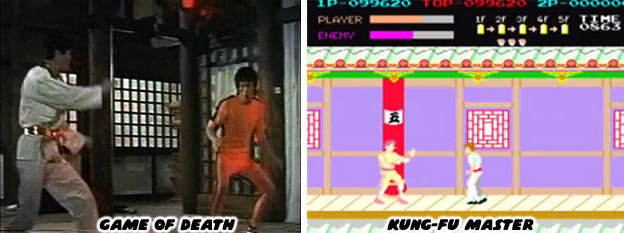
Lee's approach to the martial arts fable was original. His sense of storytelling was refreshing. When he arrived in Hong Kong he created a radically different approach to the fighting legends. He used the diversity of fighting styles, as featured in the Jimmy Wang Yu films but instead brought them down to Earth. Both Bruce and Jimmy saw that there was more potential to the genre if the styles were diversified. Rather than retell a legend where all of the characters used a form of kung-fu, both Wang Yu and Lee created new legends that exploited original styles against the established forms. This would become a staple of all great fighting films and all great fighting games. Wang Yu had the fortune of enjoying his time as a star of these features in China while Lee was struggling to find his voice in the US.
Bruce pursued his calling in Hong Kong after finding that the US had no room for an Asian lead actor. Or for that matter an Asian writer or producer. Lee had discovered that he could only get the creative freedom he enjoyed once he left Hollywood. The USA had a long history of not only white-washing Asian characters but of outright stereotyping them in cinema. The title actor in the Charlie Chan (a Chinese-American detective) was often a white actor in makeup. Even singular performances could be shocking bad, such as Mr. Yunioshi the apartment manager in the popular film Breakfast at Tiffany's. The very crude portrayal of a Japanese by Mickey Rooney was supposed to be hilarious and it was to many but not all audience members. Lee was one of many Asian-American actors that had to suffer through these indignities and social stereotypes while trying to get established. Attitudes were very poor towards minorities in the US. However that could also be said of many other large nations. On his path to fighting immortality Lee had to face the similar discrimination that were highlighted in the stories of Huo Yuan Jia, Wong Fei Hung and his own teacher Yip Man. On the other side of the Pacific the story was completely reversed. In Hong Kong cinema the Asian and Asian-American performers were revered and it was often White Westerners playing the bad guys.
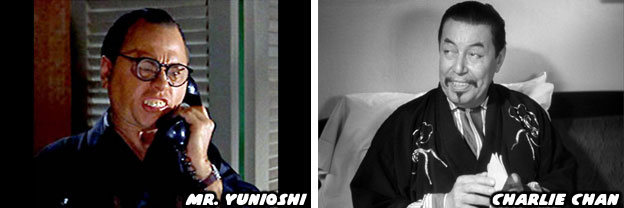
On a personal level and professional level Bruce Lee kept working through the discrimination. He translated the lessons from boxers, wrestlers and judo practitioners that he met in the US. He adapted many styles into his own method of fighting, known as Jeet-Kun Do (JKD). Lee had worked on television and films with stuntmen who were practitioners of various styles. He learned how to make movie fights seem more visceral and realistic than any other previous director. While he was in Hong Kong Lee relied more on natural movements and believable fight choreography than the wire work and stiff kung-fu routines of his contemporaries. This break in tradition opened the eyes of moviegoers around the world.
The martial arts films of the '60s and '70s had a direct influence on the fighting game genre during the '80s and '90s. It was more than just because the developer were impressionable fans but instead because there was something so universally appealing about the greatest action films. Developers created the majority of fighters based on movie tropes. There was a karate hero, a wrestler, a boxer and a kung-fu master in many early titles. The kung-fu character often mirrored the classic heroes and villains from cinema. As the genre grew many developers were looking at trying to put in fan favorite characters. Although he passed away in 1973 nobody was a bigger name than Bruce Lee. The actor would be caricatured time and time again by many studios. His moves, his look and even the costumes from his films would be copied for years to come.
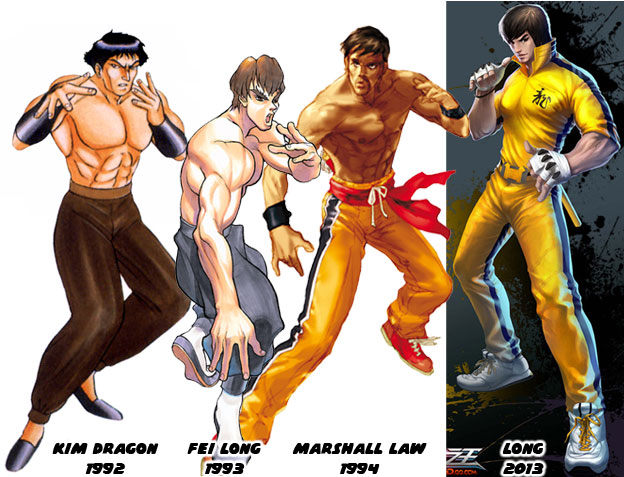
Kim Dragon was the first identifiable Bruce Lee clone. He appeared in the 1992 ADK game World Heroes. The Neo Geo title took fighters from different periods of time and put them into one tournament. To help keep from getting sued by the Lee family it was decided that Kim would be a Korean fighter of course fans could tell whom he was based on. The most popular 2D copy of Lee appeared a year later in Super Street Fighter II. Fei Long (Mandarin for Flying Dragon) made his debut in 1993 and was an eerily close copy of the iconic hero. Like Kim before him he had the trademark yell and leaping kicks. The first and longest running 3D version of the actor was Marshall Law. He appeared in Namco's Tekken in 1994. The boxing footwork and lightning fast punches that Lee was famous for looked amazing in three-dimensions. There were a few fighting characters that used Jeet-Kun Do in other franchises but they weren't as memorable as those based on Lee. The most recent clone of the actor was named Long (Dragon). He appeared in Xuan Dou Zhi Wang / King of Combat in 2013. The game was produced by Chinese developer Tencent, it was the first time that a Chinese developer built an homage to Lee in a major fighting game. Long appeared in an update to King of Combat almost 20 years to the day that Fei Long was introduced in Super Street Fighter II and almost 40 years to the day that Lee had died. Bruce Lee would continue to make cameos in various EA fighting games with permission from his family. The legend would live on forever because of how much he contributed to the martial arts and cinema in such a short amount of time.
Even though Lee's fights were refreshing on the big screen they still had a touch of the fantastic and even implausible. By a similar token (no pun intended) Kung-Fu Master lacked the special attacks of SF but it still preserved some of the more fantastic elements from kung-fu cinema. Gamers fought all sorts of rivals, including knife throwers, giants and even snakes and dragons. These fantastic creatures and opponents were a staple of the classic wuxia legends. The Sword and Sabre story that inspired the creation of the Buddha's Palm was probably as influential to the development of the wuxia genre as the Romance of the Three Kingdoms or the Water Margin. The sword was an ancient symbol of power and in theSabre story, the sword held a list of secret fighting techniques as well as a hidden treaty. Whoever could lay claim to the sword and unlock its secrets became a powerful physical person, but also had dominion over all of Asia. The Mongolians and Chinese were at war over this sword in the series. Many heroes and legends grew out of this conflict. The symbolism behind the weapons would be revisited in manhua.
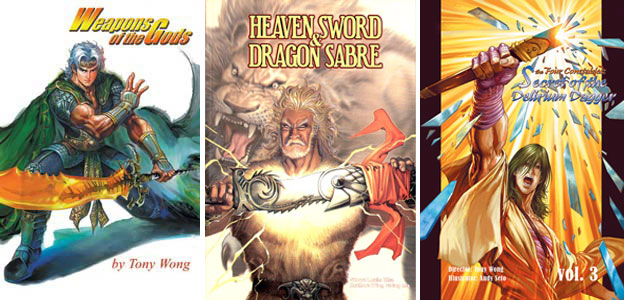
In addition to a manhua retelling of the Heaven Sword and Dragon Sabre there were other books by Tony Wong that made the weapons the central focus. The Weapons of the Gods granted martial arts masters power over nature itself, turning the owner of the weapon into a demigod. This series became extremely popular even though it followed the basic premise from the Sabrestory. The Four Constables were on the search for the Delirium Dagger in one of their adventures. Mr. Wong sold the story as based on an actual weapon that had made the wielder near invincible in combat. The Delirium Dagger increased the strength and speed of the wielder and caused opponents to suffer from extreme vertigo.
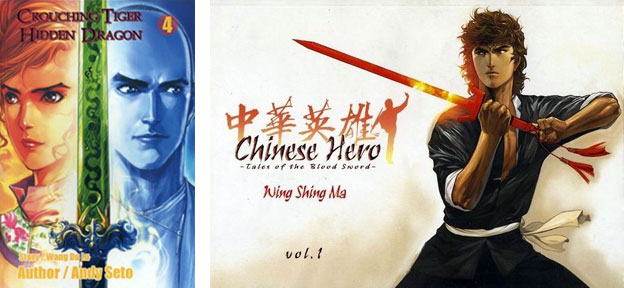
In the movie and manhua of Crouching Tiger Hidden Dragon, the main characters were fighting over a jade-colored sword named the Green Destiny. The story was part of the Crane Iron Pentalogy, a series written by Wang Dulu that captured the qualities of a hero in the classic tradition. Chinese Hero by Wing Shing Ma was an attempt at using the wuxia novel tradition in a manhua format, it was like a mid-century retelling of the heroes in the Crane Iron books. The Chinese Hero had inherited a red sword, the fabled Blood Sword which caused nothing but trouble for the young master. The fantastic art and memorable battles that Wing Shing Ma put on paper caused Tony Wong to completely change his drawing style. Prior to the 1980's Tony drew in a very early manga style, with oversized eyes and cartoonish physical proportions. After 1980, when Chinese Hero because a hit, Tony began to focus on more realistic proportions and higher quality painted panels to rival Mr. Ma.
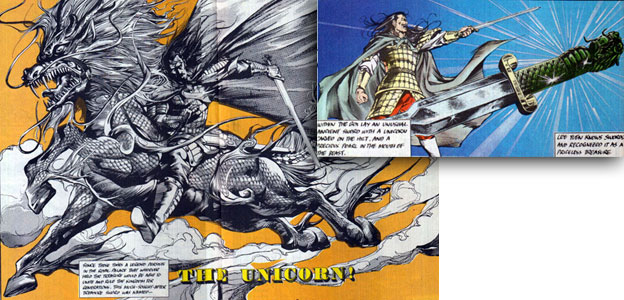
The Iron Marshal also used a fabled sword as a plot device. The Unicorn Sword was said to grant the owner unrivaled powers if they could figure out the mystery of its origin. In the series the sword traded hands several times, each owner discovered something different about the sword, including finding a secret compartment with a map to the Unicorn treasure. At one point in the story the sword edge was broken, revealing that it was a key to the treasure. Fans of the Kingdom Hearts series might be surprised to learn that the "keyblade" was not a new idea. The Unicorn Sword was undoubtedly based on the secrets hidden on the blade and scabbard of the Sabre story.

Chasing after the sword of power was even explored in the best wuxia brawling game ever, Gladiator: Road of Sword by IGS. However what was it about the wuxia legends and powerful weapons that influenced the development of Street Fighter?
The martial arts myth had a basic framework from which to work from. The pursuit of weapons with magical properties was one plot device. Substitute the weapons with the secret scrolls, books and techniques protected by martial arts masters and the template became more obvious for comics and film. Those that pursued these techniques for selfish reasons would become obsessed with achieving power. These people would betray a brother or even master to achieve more power. They became the villains. Those that accepted these techniques also accepted the responsibility to maintain peace and order became heroes. The selfish master and the selfless master would end up doing battle at some point in the story. This was far removed from the legends that created Ryu and Sagat. Fighters that wanted to prove who was the best was a good story but a greater story involved good versus evil. Sagat was a great bad guy in the Street Fighter mythos but the greater villain was the one that murdered the master of Ken and Ryu.
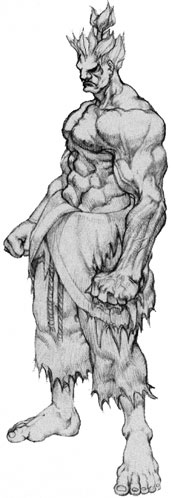
Gouki would become the model for all great fighting game bosses. He had exceptional storytelling and character designs applied to him. The archetypes in Hong Kong cinema were perfect templates for game designers to work from. All the characters needed was a little background to give them dimension. Audiences believed that these sorts of good guy and bad guy martial artists really did get together in secret tournaments but what were the origins of the mixed martial arts tournaments? The UFC would have you believe that they were the first to host such tournaments. While they are popular they were far from being the originators. In fact the roots of mixed format fights are older than Bruce Lee and even Mas Oyama. In the next entry we will look at the godfathers of mixed martial arts. As always if you enjoyed this blog and would like to sponsor me please visit my Patreon page and consider donating each month, even as little as $1 would help make better blogs and even podcasts!

No comments:
Post a Comment